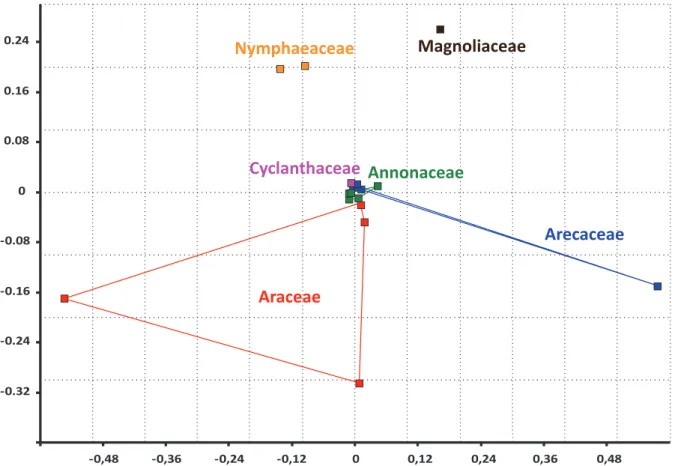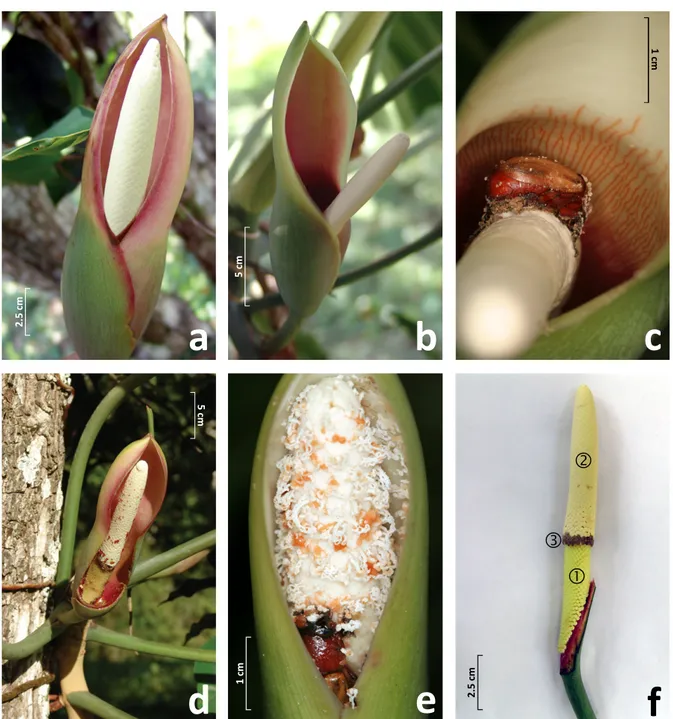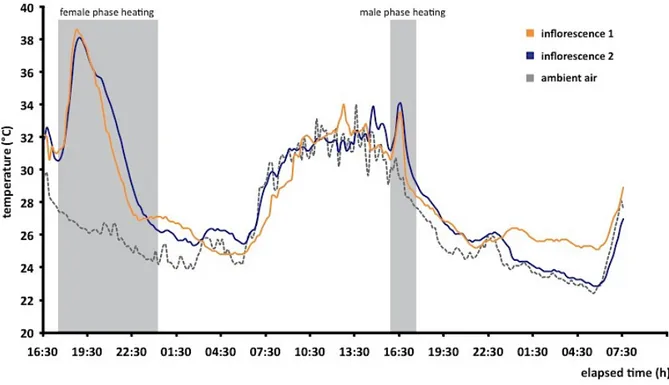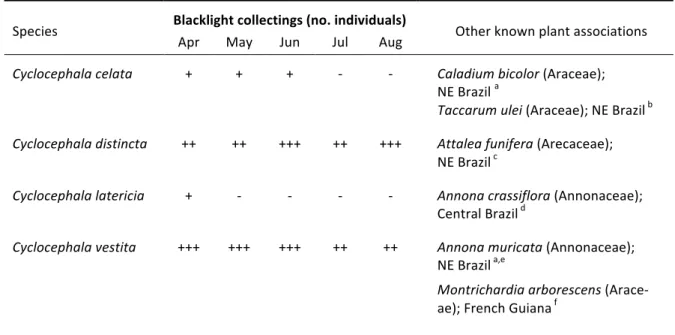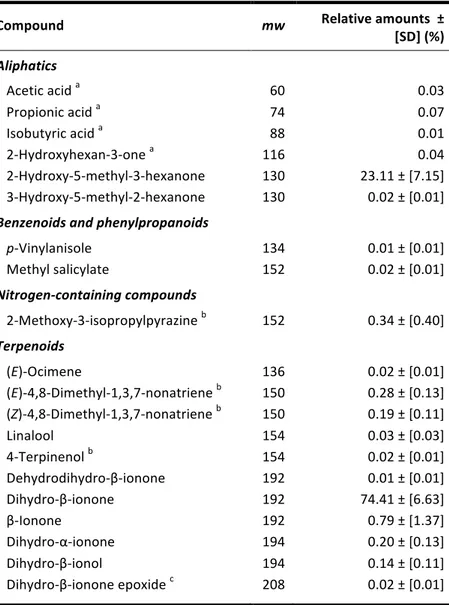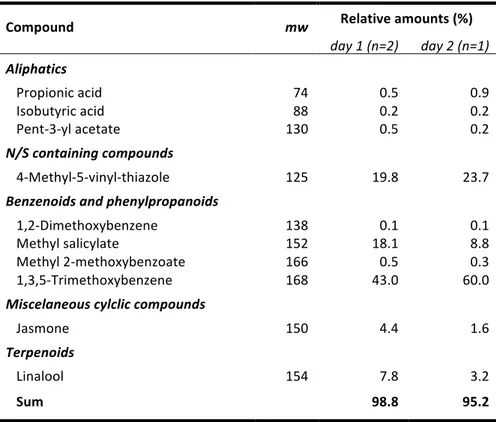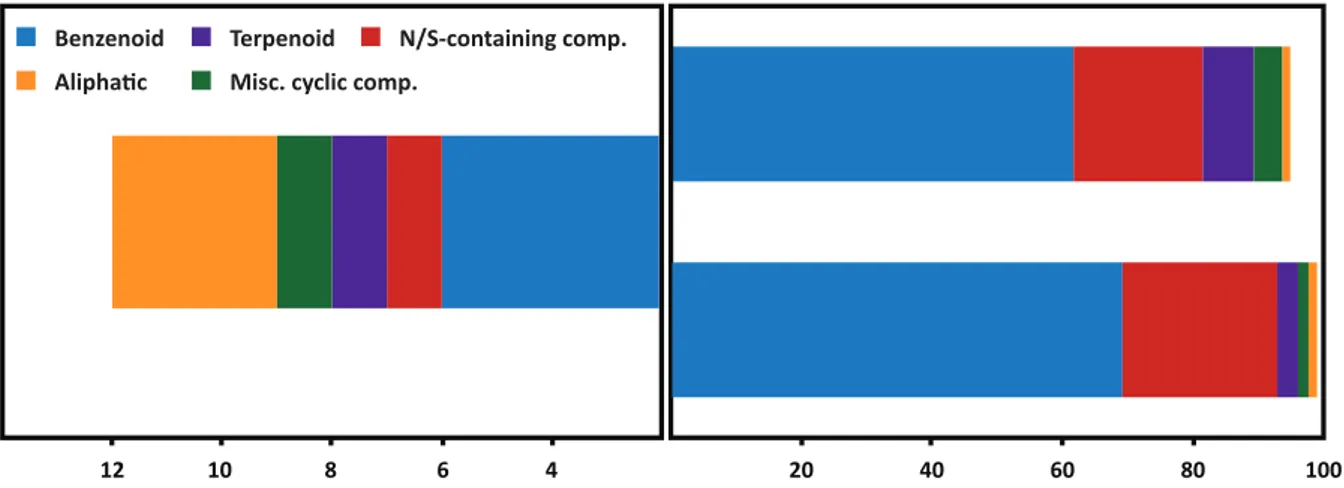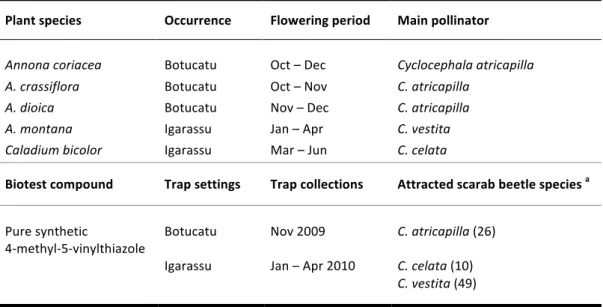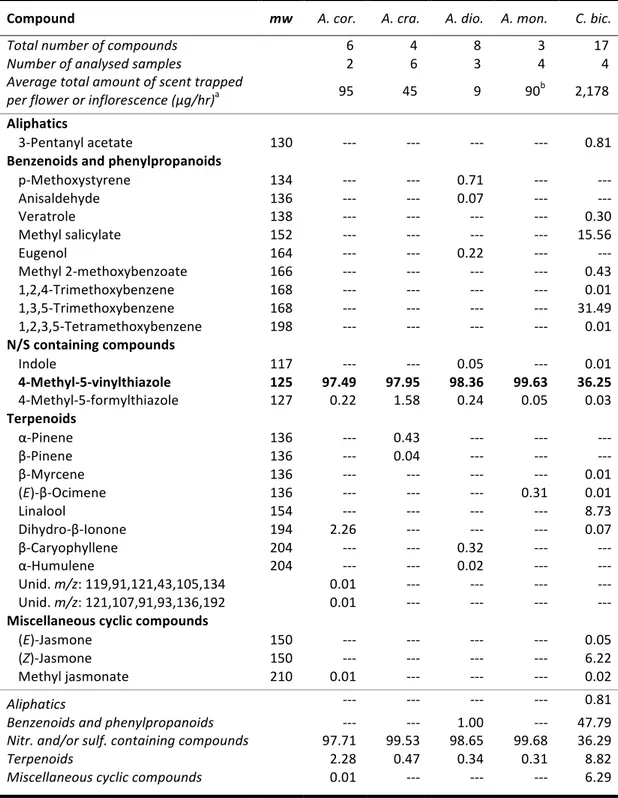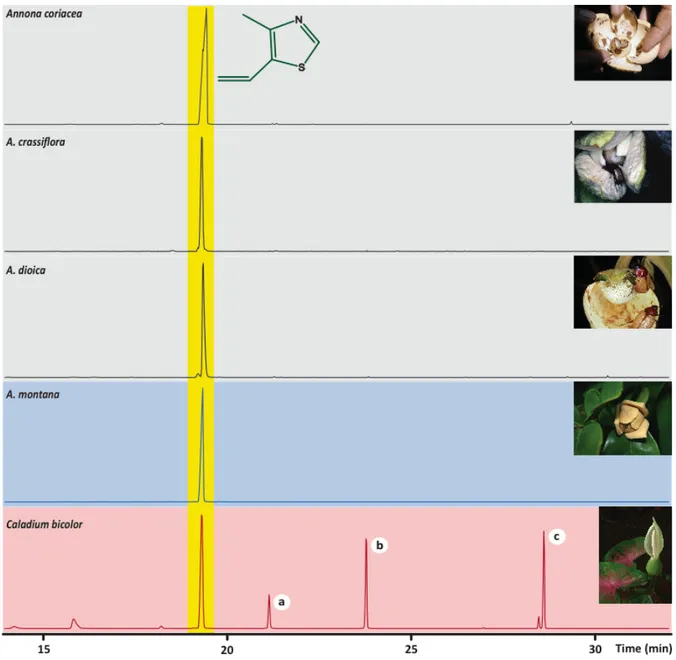DOCTORAT DE L’UNIVERSITÉ DE TOULOUSE
Délivré par :
Discipline ou spécialité :
Présentée et soutenue par :
Titre :
JURY
Ecole doctorale :
Unité de recherche :
Directeur(s) de Thèse :
Rapporteurs :
le :
Université Toulouse 3 Paul Sabatier (UT3 Paul Sabatier)
Axe 1: Ecologie, biodiversité & évolution
Artur Campos Dália MAIA
29 avril 2011
Olfactory attraction in Cyclocephalini-Aroid pollination systems and captivity
rearing of Cyclocephala
Prof. Régis CEREGHINO,
Prof. Celso Feitosa MARTINS,
Dr. Angélique QUILICHINI,
Prof. Antonio José CREÃO-DUARTE
Sciences Ecologiques, Vétérinaires, Agronomiques et Bioingénieries (SEVAB)
Laboratoire « Evolution et Diversité Biologique » EDB UMR CNRS 5174
Dr. Marc GIBERNAU, Prof. Clemens SCHLINDWEIN
Prof. Florian SCHIESTL, Prof. Vera Lucia IMPERATRIZ-FONSECA
I
This thesis is the pinnacle of several years’ personal investment, but it is also the effort of many other contributors. It would be impossible to mention everyone here, but they all know how grateful I am for having them by my side.
I am deeply thankful to my family and friends for their love, patience and unconditional sup-‐ port.
To Marc Gibernau and Clemens Schlindwein, inspirational scientists who I am lucky enough to have as supervisors.
To my friends and fellow researchers at Université Paul-‐Sabatier and Universidade Federal da Paraíba. The world of science is one of companionship, you have taught me that. To the crew of “Laboratório de Ecologia de Abelhas e da Polinização – PLEBEIA”, great peo-‐ ple and promising researchers.
To the governments of Brazil and France and their initiative of the Franco-‐Brazilian Doctoral School, which has offered me the unique opportunity of enrolling into a joint tuition PhD program.
To the members of the jury and reviewers, for accepting our invitation and for lending their expertise into the making of a better thesis.
To Roman Kaiser, for a life dedicated to uncovering the scents of nature and for his everlast-‐ ing awe in doing so.
To Bruno Arrais, Carlos Eduardo Nobre, Enio Damasceno and Christiano Fonte, which have accompanied me in many (and always fun) fieldtrips.
To Airton Torres Carvalho, arguably the best field biologist I have ever came across. To Robson Tamar, for his unrelenting dedication into making his students into scientists. To all involved with the project ‘Sustainability of Remnants of Atlantic Rainforest in Pernam-‐ buco and its Implications for Conservation and Regional Development’ within the program ‘‘Mata Atlântica: Science and Technology for the Atlantic Rainforest’. It was a pleasure to work with you.
To Frederico Cavalcante de Petribú Vilaça and Roberto Siqueira as representatives of Usina São José S/A for the possibility to execute fieldwork at its dependencies and also for logistic support.
To PROBIO, BIRD/GEF, MMA, CAPES, CNPq, BMDF and CNRS for the financial support. To Carol. I love you.
II
I studied highly specialized pollination systems involving Neotropical Araceae and scarab beetles of the tribe Cyclocephalini (Scarabaeidae, Dynastinae), and also scrutinized aspects of the ontogeny and egg development of captivity bred and reared species of Cyclocephala. Flower-‐visiting male and female Cyclocephala celata and C. latericia exhibit direct attractive response to simple chemolfactory signals in the floral scents of the Caladium bicolor, Philo-‐ dendron acutatum and Taccarum ulei. Pure authentic standards of 4-‐methyl-‐5-‐vinilthiazole and (S)-‐2-‐hydroxy-‐5-‐methyl-‐3-‐hexanone, two rare and biosynthetically diverse compounds identified as prominent constituents in floral fragrance samples among the three species of aroids, were successfully used in fragrant baits to selectively lure pollinating cyclocephaline scarab beetles. Four species of Cyclocephala native to the Atlantic Forest of northeastern Brazil, C. celata, C. distincta, C. latericia and C. paraguayensis, were successfully maintained in captivity with a simple, inexpensive rearing protocol. All species yielded viable eggs and three of them also yielded healthy imagoes on an exclusively saprophagous diet for the lar-‐ vae. Near future perspectives for the controlled, large-‐scale reproduction of these special-‐ ized pollinators offer interesting opportunities for environmental management plans of in-‐ teracting biological systems.
III
J’ai étudié les systèmes de pollinisation hautement spécialisés existant entre les Aracées néotropicales et les coléoptères de la tribu des Cyclocephalini (Scarabaeidae, Dynastinae), et aussi l’ontogénie et le développement d’espèces de Cyclocephala élevées en captivité. Les coléoptères floricoles (mâles et femelles) de Cyclocephala celata et C. latericia montrent une attraction pour de signaux olfactifs simples présents dans les senteurs florales de Caladium bicolor, Philodendron acutatum et Taccarum ulei. Des molécules synthétisées de 4-‐methyl-‐5-‐ vinilthiazole et (S)-‐2-‐hydroxy-‐5-‐methyl-‐3-‐hexanone, deux composés rares issus de voies bio-‐ synthétiques différentes, et majeurs des odeurs florales des trois espèces d’Aracées étu-‐ diées, se sont avérées très attractives et de manière sélective pour les espèces pollinisatrices de Cyclocephala. En élevage, quatre espèces de Cyclocephala indigènes de la forêt Atlan-‐ tique du Nord-‐est Brésil, C. celata, C. distincta, C. latericia et C. paraguayensis, furent main-‐ tenues en captivité durant tout leur cycle biologique grâce à un protocole a simple et éco-‐ nomique. Des œufs viables furent pondus pour toutes les espèces, et pour trois d’entre elles le stade imago fut obtenu à partir d’une diète exclusivement saprophage des larves. Des perspectives de production contrôlée à grande échelle de ces pollinisateurs spécialisés offre des opportunités intéressantes pour la gestion environnementale des systèmes biologiques en interaction.
Mots clés: pollinisation à médiation olfactive, Araceae, Cyclocephala, odeurs florales, ontogenèse
IV
Eu estudei sistemas de polinização altamente especializados envolvendo aráceas Neotropi-‐ cais e besouros escarabeídeos da tribo Cyclocephalini (Scarabaeidae, Dynastinae), e também elucidei aspectos da ontogenia e desenvolvimento embrionário de espécies do gênero Cyclocephala mantidas em cativeiro. Machos e fêmeas antófilos de Cyclocephala celata e C. latericia apresentam resposta atrativa direta a sinais químico-‐olfatórios simples, presentes nos odores florais de Caladium bicolor, Philodendron acutatum e Taccarum ulei. Padrões pu-‐ ros de 4-‐metil-‐5-‐viniltiazol e (S)-‐2-‐hidroxi-‐5-‐metil-‐3-‐hexanona, dois compostos raros e bio-‐ sintenticamente diversos isolados em amostras de fragrâncias florais das três espécies vege-‐ tais estudadas, foram utilizados com sucesso na atração seletiva de espécies polinizadoras de Cyclocephala. Quatro espécies do gênero nativas da Floresta Atlântica do Nordeste brasi-‐ leiro, C. celata, C. distincta, C. latericia e C. paraguayensis, foram mantidas em cativeiro du-‐ rante todo o ciclo biológico através da aplicação de um protocolo simples e econômico. Fo-‐ ram obtidos ovos viáveis de todas as espécies, e imagos de três destas se desenvolveram a partir de uma dieta larval exclusivamente saprófaga. Perspectivas para a reprodução contro-‐ lada e em maior escala para espécies polinizadoras de Cyclocephala num futuro próximo oferecem oportunidades interessantes para a gestão ambiental e manejo em sistemas bio-‐ lógicos.
Palavras-‐chave: polinização olfatório-‐mediada, Araceae, Cyclocephala, odores florais, ontogênese.
ACKOWLEDGMENTS ... I ABSTRACT ... II RÉSUMÉ ... III RESUMO ... IV
Summary
1. General introduction ... 1 2. Presentation ... 3 3. Overall discussion ... 54. Conclusions and perspectives ... 8
Literature cited ... 9
Chapter 1. Pollination of Philodendron acutatum (Araceae) in the Atlantic Forest of
northeastern Brazil: a single scarab beetle species guarantees high fruit set
Abstract ... 12
1.1 Introduction ... 13
1.2 Material and methods ... 14
1.3 Results ... 17
1.4 Discussion ... 20
Literature cited ... 23
Chapter 2. The inflorescence odour of Caladium bicolor (Araceae), a Neotropical
aroid pollinated by cyclocephaline scarabs (Scarabaeidae, Dynastinae)
Abstract ... 27
2.1 Introduction ... 28
2.2 Experimental ... 29
2.3 Results and discussion ... 30
Literature cited ... 32
Chapter 3. Private communication channel between basal angiosperms and
pollinating beetles
Summary ... 36 3.1 Main text ... 37 3.2 Methods summary ... 42 Literature cited ... 42Chapter 4. Reproductive biology of Taccarum ulei (Araceae, Spathicarpeae)
Abstract ... 45
4.1 Introduction ... 46
4.2 Material and methods ... 47
4.3 Results ... 49
4.4 Discussion ... 55
Literature cited ... 57
Chapter 5. The floral scent of Taccarum ulei (Araceae): attraction of scarab beetle
pollinators to an unusual aliphatic acyloin
Abstract ... 615.1 Introduction ... 62
5.2 Material and methods ... 62
5.3 Results ... 66
5.4 Discussion ... 69
Literature cited ... 72
Chapter 6. Captivity rearing and breeding of Cyclocephala species: results on
ontogeny and egg development during embryogenesis
Abstract ... 746.1 Introduction ... 75
6.2 Material and methods ... 76
6.3 Results and discussion ... 77
Literature cited ... 84
PUBLICATIONS FROM THIS THESIS (CO-‐AUTHORS AND AFFILIATIONS) …………...……….. 87
[1]
1. General introduction
The association between insects and flowering plants may be tracked back to the origin of the latter, about 135 m.y.a. [1,2]. In the absence of floral color, specialized food bodies or nectaries in early flowers, odoriferous volatiles may have been key components of early angiosperm breeding systems [3]. Pellmyr and Thien [4] suggested that in these primitive flowering plants, floral odors functioned as chemical signals to insects for food and mating sites, which subsequently led even to co-‐dependency of the sexual life cycle of insects and plants. Such assumption is supported by the fact that many of the most basal families of magnoliids and monocots commonly produce strong floral fragrances, associated with heat production by the flowers (or inflorescences) [5,6]. Floral thermogenesis, first verified by Lamarck in the 18th century, is known to occur in eleven extant an-‐
giosperm families [7]. It consists of a physiological process during which carbohydrates or lipids stored in specific floral tissues are burnt to raise their temperatures above that of the surrounding air, thus enhancing volatilization of scented compounds [8]. Strong odor emission, coupled to floral thermogenesis, is a trait preponderantly associated with pollination by beetles (cantharophily) and flies (myiophily) [9], most likely the first animal pollinators [2,10].
Cantharophilous pollination systems often exhibit a high degree of specialization, involving del-‐ icate synchrony heat generation and odor emission to pollinator activity [11]. Shelter, warmth, food and mating/oviposition sites for the visiting beetles seem to be the major driving forces behind can-‐ tharophily [12]. Flowers and inflorescences visited by beetles are commonly modified into robust floral chambers, with abundant nutritious tissues and pollen [11].
Among the known taxa of flower-‐visiting beetles, scarabs of the tribe Cyclocephalini (Scarabae-‐ idae, Dynastinae) are likely the most preponderant and diverse [13]. From what is currently known, cyclocephaline scarabs are the sole pollinators of no less than 900 species of angiosperms among the Nymphaeaceae, Magnoliaceae, Annonaceae, Cyclanthaceae, Arecaceae and Araceae [6,10,13-‐ 17].
Cyclocephaline scarabs are restricted to the Americas, with the exception of two species of the genus Ruterolyctes, native to West Africa [18]. About 14 genera are currently known from the tribe, from which Cyclocephala comprises more than 85% of the richness, with about 350 described spe-‐ cies from extreme southeastern Canada south to Argentina and in the Caribbean. All adult cy-‐ clocephaline scarabs are nocturnal and most are attracted to lights at night [19]. Their size range from ca. 10-‐35 mm, positioning them as the largest-‐sized of beetle pollinators when compared to other anthophilous taxa (eg. Nitidulidae, Curculionidae, Staphylinidae and Chrysomelidae) [20].
Flower visiting cyclocephaline scarabs have a keen detection of scent, as they are often seen in a "honing-‐in" pattern towards fragrant sources [21]. Among the Araceae, compositional analogies of floral scent chemistry can be evidenced out of few available studies [22,23]. The odor of the inflo-‐ rescences of Montrichardia arborescens (Arruda) Schott is dominated by a cyclopentenone deriva-‐
tive (jasmone) and a few benzenoid derivatives (methyl benzoate, methyl salicylate, 1,3,5-‐ trimethoxybenzene, 2-‐pentenyl-‐oxy-‐benzene) [24]. Analogous compounds are commonly emitted by flowers/inflorescences of many large beetle-‐pollinated taxa (Eupomatia, Encephalartos, Lirio-‐ dendron, Magnolia, Michelia, Nelumbo, Zamia), sometimes as major compounds, and may well be implicated in beetle attraction [23]. Methoxylated benzenoids are particularly well represented in the scents of cyclocephaline scarab-‐pollinated Nymphaea and Victoria (Nymphaeaceae) [10,25], but are otherwise uncommon in angiosperms [23]. Lopez et al. [26] hold a US patent of a scented bait for monitoring and controlling Cyclocephala and other scarabs, composed of a mix of phenyl acetal-‐ dehyde, 2-‐phenylethanol, limonene, methyl-‐2-‐methoxybenzoate, and methyl salicylate.
Analogies in floral scent composition might be responsible for the observation that cyclocepha-‐ line scarabs are not very species-‐specific and frequently switch from flowering a species to another if they are in bloom at the same time [13,27]. Not only will some species of beetles switch from one species to the next, as is known for certain pollinators of Dieffenbachia [28] and Philodendron [29-‐ 31], but will also switch to another genus, tribe or even family [27]. For instance, Cyclocephala colasi Endrödi, 1964 is the main pollinator of both Montrichardia arborescens [24] and Philodendron soli-‐ moensense A.C. Smith in French Guyana [29]. Another undescribed species is a regular flower visitor of sympatric populations of Dieffenbachia longispatha Engl. & K. Krause (Araceae) [28] and Cyclan-‐ thus bipartitus Poit. ex A. Rich. (Cyclanthaceae) [14] in La selva, Costa Rica. In Brazil, C. latericia Höhne, 1923 is found on inflorescences of Taccarum ulei Engl. & K. Krause (Araceae) in the Atlantic Rainforest [CHAPTER IV], but it is also a known pollinator of Annona crassiflora Mart. (Annonaceae) in
Cerrado [32].
An assumption that summarizes the odoriferous chemical interaction within these pollination systems to simple sets of floral volatiles seems, nevertheless, unwarranted. Schatz [13] emphasizes, for example, to the high degree of specificity that is exhibited by Philodendron radiatum Schott and by an unidentified species of Cyclocephala in La Selva, Costa Rica. The aroma given off by P. radia-‐ tum is particularly unique in that it is made up of compounds that are found in this species alone [27]. It seems logic that specific attractants exist in many different aroids, due to the fact that many flowering species attract principally a single type of beetle [27]. For instance, strong and spicy floral fragrances given off by upland Atlantic Forest populations of Philodendron selloum K. Koch are high-‐ ly attractive to a single beetle species, Erioscelis emarginata Mannerheim 1829, upon which this species probably rely as the only effective pollinator [33]. Even more intricate relationships are to be found, as observed in syntopic populations of Philodendron acutatum Schott, Caladium bicolor (Ai-‐ ton) Vent. and Taccarum ulei in the Atlantic Forest of northeastern Brazil. Among those, C. latericia visits solely inflorescences of the latter [CHAPTER IV], whereas congeneric C. celata Dechambre, 1980
seems to be more generalistic, visiting inflorescences of all three aroids, indistinctively [CHAPTER I; CHAPTER IV].
Further comparative studies are strongly needed with floral odors of cantharophilous Araceae in order to assess the cues by which distinct cyclocephaline scarab beetle species respond to select-‐ ed attractive volatiles. Characterization of floral fragrances from distinct aroid species and ever-‐ lacking detailed experiments on the behavior of the scent-‐driven pollinators should yield important
conclusions on the particular aspects of the syndrome, as well as clearer results on the set of attrac-‐ tive volatiles involved.
Cyclocephalini -‐ life cycle and biology
Much of what is currently known about the life cycles of cyclocephaline scarab beetles relies on data of species associated to agricultural systems and pastures [34-‐37]. Scientific literature men-‐ tions genera Cyclocephala and Erioscelis as rhizophagous and saprophagous [20,38], but there is ur-‐ gent need for more detailed studies. One of the species of Cyclocephala that has been thoroughly studied regarding its biology is C. lurida Bland, 1863, a major pest concern of garden lawns and golf courses in North America [34].
The complete life cycle of this species takes the course of one year. Adult beetles emerge, ma-‐ te, and lay eggs in midsummer, mainly from late June until early August. As common to most Dynas-‐ tinae, females burrow into the substrate to lay their eggs, which hatch in about two weeks. First in-‐ star grubs grow quickly, feeding on fine roots and organic matter. Grubs molt twice as they grow and most of them are third instars by late summer or early fall. In October or November, when soil temperatures begin to cool, the grubs cease feeding and move deeper into the soil, where they spend the winter. They return to the root zone and resume feeding early the following spring. When mature (typically in late May), the grubs again move deeper, form an earthen cell, and trans-‐ form into pupae. The adult beetles emerge a few weeks later, in June and July, to complete the one-‐ year cycle [39].
Accomplishment in rearing viable imagoes from insects captured in the wild should yield valu-‐ able material for experimental purposes. Furthermore, it would be a first step towards pollinator management of these insects, which are not only essential to the reproductive success of angio-‐ sperms in natural ecosystems, but also to some economically important fruit cultures, like that of the soursop (Anonna muricata L., Annonaceae) [40,41]. Studies on the ontogenic development of Cyclocephala are currently restricted to less than 3.0% of the known species, none of which native to the Atlantic Forest.
2. Presentation
The core theme of this thesis lies on the elucidation of details of the scent-‐mediated pollination mutualisms involving cyclocephaline scarab beetles of the genus Cyclocephala and Neotropical ar-‐ oids. Essential knowledge of the life cycles of these highly specialized pollinators is also presented, along with the development of easily applicable captivity breeding/rearing protocols for these in-‐ sects. The results were compiled in six chapters structured as individual manuscripts for scientific journals. Formatting and diagramation of the text were chosen by the author and do not reflect the norms of specific journals to which they will be submitted, for the purpose of standardization.
CHAPTER I consists on a study of the pollination biology of Philodendron acutatum Schott. (Arace-‐ ae), emphasizing on the role of a scent-‐driven species of scarab beetle as the exclusive pollinator of indigenous populations of the aroid in a fragmented landscape of the Atlantic Forest domain of
northeastern Brazil. When published at the International Journal of Plant Sciences in September 2010, it presented for the first time the detailed floral scent composition of a Neotropical aroid pol-‐ linated by cyclocephaline scarab beetles. Results show that P. acutatum is self-‐incompatible as a consequence of protoginy and relies solely on Cyclocephala celata to achieve reproductive success. High fructification rates observed during the study clearly indicate that the plant-‐pollinator relation-‐ ship is locally stable and not particularly prone to the deleterious effects of fragmentation and re-‐ duction of original forest cover.
CHAPTER II is a complete depiction of the floral scent composition of Caladium bicolor, a geophytic aroid pollinated by cyclocephaline scarabs. This species grows in the same locality as P. acutatum and allowed a comparative study on the chemical aspect of the pollination biology. The main result of this research is the identification of a novel floral volatile compound, 4-‐methyl-‐5-‐vinylthiazole, as a prominent constituent of the fragrance of C. bicolor.
CHAPTER III confirms with behavioral experiments the major role of 4-‐methyl-‐5-‐vinyltiazole in spe-‐ cific attraction of cyclocephaline scarab beetle pollinators. The result that a single volatile com-‐ pound can induce positive attractive responses of the pollinators of C. bicolor is totally new. By comparing the floral scent composition of C. bicolor to that of other plants sharing the same pollina-‐ tion syndrome, we also provide an original report of convergently evolved ‘private communication channels’ within unrelated lineages of basal angiosperms.
CHAPTER IV is focused on the reproductive ecology of Taccarum ulei, a poorly understood geo-‐ phytic aroid of the tribe Spathicarpeae, and the role of singular groups of insect visitors as highly-‐ specialized pollinators or flower predators. Different defining aspects of floral morphology and physiology, including general inflorescence buildup and detailed characterization of thermogenesis are presented. Taccarum ulei was characterized as an unusual cyclocephaline scarab-‐pollinated ar-‐ oid when taken into account its color presentation and the close relationship with fruit-‐visiting flies (Melanoloma sp., Richardiidae). Comparison of specific sets of floral traits to those of other known aroids confirm similarities with taxa that exhibit a beetle pollination syndrome.
CHAPTER V includes the characterization of the floral scent composition of Taccarum ulei and the investigation of the role of prominent volatile constituents in the overall fragrant bouquet as effec-‐ tive attractants of pollinating cyclocephaline scarabs. Two uncommon compounds dominate the floral odor and we found a new behaviorally active compound, the aliphatic acyloin (S)-‐2-‐hydroxy-‐5-‐ methyl-‐3-‐hexanone. Analogies and dissimilarities in the floral scents of syntopic aroids sharing the same pollinators are highlighted, particularly the fact that the same two compounds dominate the floral scent of P. acutatum, only in different proportions.
CHAPTER VI depicts the egg development and ontogeny of four species of Cyclocephala native to the Atlantic Forest of northeastern Brazil. The research adds up to the very limited studies about the captivity breeding and rearing of these insects and offers initial protocols for the controlled, large-‐scale reproduction of specialized pollinators in the near future. Moreover we gather interest-‐ ing ecological data on the studied species and learn the durations of immature and adult cycles.
3. Overall discussion
The pollination systems scrutinized in this thesis are all characterized by the release of very strong floral fragrances, a typical strategy among night-‐blooming angiosperms which apply olfactory trails as the main attractivity signal for effective pollinators [7,11,12].
We have encountered simple compound blends in the analyzed samples of the three species. Not only were there few constituents (less than 20) in each of the floral bouquets, they each only contained two to four prominent compounds that accounted for over 95% of total scent discharge
[CHAPTERS I, II, V]. This presentation is rather contrasting with the scenario portrayed for most plant
taxa pollinated by highly specialized insect pollinators, in which the complexity of floral scent blends easily surpasses 80 constituents [42,43]. Often, it is in this very complexity that lays the trigger for behavioral responses of pollinators, and several compounds might act synergistically within a very narrow concentration range upon discharge to be attractive [44].
Unlike what was previously expected, benzenoid and phenylpropanoid derivatives were not linked to the attraction of cyclocephaline scarab pollinators to fragrant inflorescences of Caladium bicolor, Philodendron acutatum or Taccarum ulei [CHAPTERS I, II, V]. This class of compounds was
actually absent from the pungent, yeasty-‐like odor of the analyzed samples of T. ulei and accounted to less than 0.05% of the scent discharge of P. acutatum. Nonetheless, methoxylated benzenoids were particularly well represented in the scent of C. bicolor and 1,3,5-‐trimethoxybenzene, the largest peak in the sweet-‐scented analyzed samples, accounted to 43-‐60% of the total blend
[CHAPTER II]. Attractivity biotests, however, revealed that it was another compound, rather than
1,3,5-‐trimethoxybenzene, which elicited behavioral responses of the effective pollinator of the species in northeastern Brazil [CHAPTER III].
A simple comparative analysis of the floral scents of the three aroid species rapidly showed that the composition of Caladium bicolor bore no major similarities to that of the other two, whereas the fragrances of P. acutatum and T. ulei presented exactly the same prominent constituents (refer to table 1 in CHAPTER V). The novel floral scent molecule isolated in C. bicolor, 4-‐
methyl-‐5-‐vinylthiazole, was actually identified among unrelated Annona (Annonaceae) pollinated by cyclocephaline scarabs, also as a major compound [CHAPTER III]. Field biotests with undiluted
authentic standard of this floral volatile proved it to be highly attractive to pollinating Cyclocephala scarabs [CHAPTER III]. This kind of behavioral response to a specific chemical compound, regardless of
its concentration or relative amount in a complex mix, is very uncommon in plant-‐pollinator mutualisms. In these ‘private communication channels’ of scent-‐driven pollination mutualisms, exclusive floral fragrance blends or isolated compounds exert taxa-‐restricted attractiveness towards specific flower visitors [44]. Such strictness is often attributed to rare bioactive compounds, synthesized in unusual metabolic pathways that are ultimately irreproducible by chance [45]. The rare monoterpene (E)-‐carvone oxide was only ever isolated among plant taxa pollinated by fragrance-‐seeking male euglossine bees [43,46-‐49] and functions as a main attractive signal for innumerous species of these highly specialized pollinators [50].
The main compounds in the floral scents of Philodendron acutatum and T. ulei were also tested in both field and controlled biotests [CHAPTER V]. Our results indicate that (S)-‐2-‐hydroxy-‐5-‐methyl-‐3-‐ hexanone is a attractive to Cyclocephala celata and Cyclocephala latericia, whereas the other major compound in the blend of the two species, dihydro-‐β-‐ionone, seems to play no role in luring the scarab beetles. It may be that other cyclocephaline scarab-‐pollinated taxa have similarly adopted the strategy of utilizing specific compounds to attain pollinator selectivity. The floral scent of Cyclanthus bipartitus Poit. ex A. Rich (Cyclanthaceae), whose thermogenic inflorescences are visited by two species of Cyclocephala, is dominated by an exclusive homoterpene, (E)-‐cyclanthone (> 85% of the floral blend) [51]. Unusual methoxylated esters found in the scent of Nymphaea lotus L. (Nymphaeaceae) could well be involved in the attraction of Ruteloryctes morio Fabricius, 1798 effective pollinator of indigenous populations of the water lily in West Africa [10].
At first, it seemed obvious that analogies in pollinator specificity and floral scent composition among the three species of Araceae approached in the present study would provide information regarding the details of pollinator attractivity. The fact that they all shared a common pollinator, C. celata, suggested that the three species of aroids would apply similar chemical cues for pollinator attractivity, likely through the selection of a specific compound or a particular compound blend. Although scent can explain the selectivity towards a certain group of pollinators, as it was the case of Cyclocephala and the studied aroids, there is a clear barrier in the intent of defining the details involved in the specificity of the relationships. From our observations, it is clear that 4-‐methyl-‐5-‐ vinylthiazole and (S)-‐2-‐hydroxy-‐5-‐methyl-‐3-‐hexanone play the role of main attractive cues for Cyclocephala beetles, defining the pollination syndrome. How these species assure effective pollen transfer through pollinator selectivity, nonetheless, might involve complex multicomponent floral filters which could not be tackled in the present study (eg. stratification, differences in flowering periods, acquired/learnt preferences by the insects). From an exclusively olfactory-‐based standpoint, Whitten [50] has showed that among orchids, interaction exclusiveness is attained with increasing complexity of floral scent composition in addition to a main olfactory signal. We might expect the same within cyclocephaline scarab-‐pollinated Araceae, but at a lower degree, since their floral scents are far more modest in composition (less than 20 compounds) [CHAPTERS I, II, V]. Less
complex attractive signals might result in a laxer degree of specialization and in fact it is not unusual that a given species of cyclocephaline scarab is observed on different host plants in the same window of time [13,27,52].
This low degree of olfactory signal complexity is also clearly shown by a NMDS analysis of floral bouquets of taxa sharing the same pollination syndrome (fig. 1). Distances between floral bouquets represent differences not in terms of the chemical groups constituting the floral odor, but rather in terms of compound blend complexities. When discarded the compounds which encompassed less than 1% of the total blend, most of the species (12 out of 18; 66.7%) are distributed around the origin of the graph as a consequence of their simple floral compositions (three or less compounds). Even the most complex floral odor, belonging to the Arecaceae Bactris gasipaes Kunth [53], is relatively simple with 11 compounds if compared to orchids floral scents containing many tens of compounds [43]. Hence, it seems that in evolutionary terms, angiosperms pollinated by
cyclocephaline scarab beetles present floral odors with a limited complexity in terms of numbers of compounds, although often dominated by unusual prominent compounds that ensure their originality.
-‐0,48 -‐0,36 -‐0,24 -‐0,12 0 0,12 0,24 0,36 0,48 -‐0.32 -‐0.24 -‐0.16 -‐0.08 0 0.08 0.16 0.24
Araceae
Arecaceae
Annonaceae
Cyclanthaceae
Nymphaeaceae
Magnoliaceae
Figure 3. Non-‐metric multidimensional scaling (NMDS) representation of the floral scent composition of
18 angiosperm taxa pollinated by cyclocephaline scarab beetles (Scarabaeidae, Dynastinae). Only the compounds encompassing over 1% of overall relative composition were pooled for analysis. Species nearer the core of the graph are comprised by fewer compounds, whereas those nearer the edges present more complex compositions. List of taxa included: Annonaceae -‐ Annona coriacea, A. crassiflora, A. dioica, A. montana [CHAPTER III], and A. muricata [MAIA ET. AL. UNP. DATA]; Araceae -‐ Caladium bicolor [CHAPTER II], Montrichardia linifera [MAIA ET. AL. UNP. DATA], Philodendron acutatum [CHAPTER I], Taccarum ulei [CHAPTER V].
Arecaceae -‐ Aphandra natalia, Phytelephas aequatorialis, P. macrocarpa, P. seemanyi (Ervik et al. [53]), and Bactris gasipaes (Knudsen et al. [54]); Cyclanthaceae -‐ Cyclanthus bipartitus (Schultz et al. [51]); Nymphaeaceae -‐ Victoria cruziana, V. amazonica (Kaiser [25]); Magnoliaceae -‐ Magnolia tamaulipana (Azuma et al. [55]).
4. Conclusions and perspectives
It became clear that simple chemolfactory signals play a key role in the attraction of pollinating cyclocephaline scarab beetles in the plant-‐insect mutualisms portrayed in this thesis. Unusual and biosynthetically diverse compounds (e.g. 4-‐methyl-‐5-‐vinylthiazole and (S)-‐2-‐hydroxy-‐5-‐methyl-‐3-‐ hexanone) elicit direct behavioral response of Cyclocephala celata and C. latericia with a rather ac-‐ centuated degree of selectivity, ensuring specialized pollination services and increased chances of effective cross-‐pollen transfer. These findings pave the way for further investigations into the de-‐ tails of scent-‐mediated attraction in other similar pollination systems, which should soon add up to a more detailed depiction of the ‘cyclocephaline scarab pollination syndrome’. Data on floral scents alone undoubtedly indicate that several untested compounds might play a role in the attraction of different species of cyclocephaline scarab beetles, an open field for upcoming research.
We are still unable to make deeper inferences about how the three species of aroids depicted in this study share a common pollinator and manage to guarantee exceptional reproductive success [CHAPTERS I, II, IV]. It might be that subgroups within the local populations of C. celata respond more
intensely to either 4-‐methyl-‐5-‐vinylthiazole or (S)-‐2-‐hydroxy-‐5-‐methyl-‐3-‐hexanone, probably through mechanisms of learnt preference. Naïve individuals should be innately attracted to main chemolfatory signals and then become more selective towards specific hosts once they are familiar-‐ ized with more complex floral bouquets [56,57]. This assumption, however, relies on submitting both naïve and experienced individuals to the same set of controlled behavioral bioassays. The suc-‐ cess in rearing and breeding Cyclocephala in captivity improves the probability that such experi-‐ ments are performed in the near future.
Literature cited
[1] Barth F.G. (1991) Insects and Flowers: The Biology of a Partnership. Princeton University Press, New Jersey.
[2] Grimaldi, D., and M.S. Engel (2005). Evolution of the insects. Cambridge University Press, Cambridge.
[3] Azuma H., L.B. Thien, and S. Kawano (1999). Floral scents, leaf volatiles and thermogenic flowers in Magnoliaceae. Plant Sp Biol 14, 121-‐127.
[4] Pellmyr O., and L.B. Thien (1986). Insect reproduction and floral fragrances: Keys to the evolution of the angiosperms? Taxon 35, 76-‐85.
[5] Meeuse B.J.D., and I. Raskin (1988). Sexual reproduction in the Arum lily family with emphasis on thermogenicity. Sexual Plant Reproduction 1, 3-‐15.
[6] Gottsberger G. (1990). Flowers and beetles in the South American tropics. Bot Acta 103, 360-‐365. [7] Thien L.B. et al. (2009). Pollination biology of basal angiosperms (ANITA grade). Amer J Bot 96, 166-‐
182.
[8] Seymour R.S., C.R. White, M. Gibernau (2003). Heat reward for insect pollinators. Nature 426, 243-‐ 244.
[9] Endress P.K. (1996) Diversity and Evolutionary Biology of Tropical Flowers. Cambridge University Press, Cambridge.
[10] Ervik F., J.T. Knudsen (2003). Water lilies and scarabs: faithful partners for 100 million years? Biol J Linn Soc 80, 539-‐543.
[11] Gottsberger G. (1986). Some pollination strategies in neotropical savannas and forests. Plant Syst Evol 152, 29-‐45.
[12] Bernhardt P. (2000). Convergent evolution and adaptive radiation of beetle-‐pollinated angio-‐ sperms. Plant Syst Evol 222, 293-‐320,
[13] Schatz G.E. (1990). Some aspects of pollination biology in Central American forests. Pages 69-‐84 in K.S. Bawa, and M Hadley eds. Reproductive Ecology of Tropical Forest Plants. Parthenon, Paris. [14] Beach J.H. (1982). Beetle pollination of Cyclanthus bipartitus (Cyclanthaceae). Amer J Bot 69, 1074-‐
1081.
[15] Silberbauer-‐Gottsberger I. (1990). Pollination and evolution in palms. Phyton 30, 213-‐223.
[16] Dieringer G., L. Cabrera, M. Lara, L. Loya, and P. Reyes-‐Castillo (1999). Beetle pollination and floral thermogenicity in Magnolia tamaulipana. Int J Plant Sci 160, 64-‐71.
[17] Silberbauer-‐Gottsberger I., G. Gottsberger, and A.C. Webber (2003). Morphological and functional flower characteristics of New and Old World Annonaceae with respect to their mode of
pollination. Taxon 52, 701-‐718.
[18] Ratcliffe B.C., and R.D. Cave (2006). The dynastine scarab beetles of Honduras, Nicaragua, and El Salvador. Bulletin of the University of Nebraska State Museum 21, 1-‐424.
[19] Endrödi S. (1985) The Dynastinae of the World. Dr. W. Junk Publishers, Budapest.
[20] Lawrence F.A., A.M. Hasting, M.J. Dallwitz, T.A. Paine, and E.J. Zurcher (1999). Beetles of the World. A Key and Information System for Families and Subfamilies. Version 1.0 for MS-‐Windows. CSIRO Publishing, Melbourne.
[21] Gottsberger G., and I. Silberbauer-‐Gottsberger (1991). Olfactory and visual attraction of Erioscelis emarginata (Cyclocephalini, Dynastinae) to the inflorescences of Philodendron selloum (Araceae). Biotropica 23, 23-‐28.
[22] Dobson H.E.M. (2006). Relationship between floral fragrance composition and type of pollinator. Pages 148-‐198 in N. Dudareva, and E. Pichersky eds. Biology of Floral Scent. CRC Press, Boca Raton. [23] Knudsen J.T., R. Eriksson, J. Gershenzon, and B. Ståhl (2006). Diversity and distribution of floral
scent. Bot Rev 72, 1-‐120.
[24] Gibernau M., D. Barabé, D. Labat, P. Cerdan, and A. Dejean (2003). Reproductive biology of Montrichardia arborescens (Araceae) in French Guiana. J Trop Ecol 19, 103-‐107.
[25] Kaiser R. (2006). Meaningful Scents Around the World: Olfactory, Chemical, Biological, and Cultural Considerations. Wiley-‐VCH, Zurich.
[26] Lopez J.D., R.L. Crocker, and T.N. Shaver (2002). Attractant for monitoring and control of adult scarabs. United States Patent 6440406, Issued on August 27, 2002.
[27] Croat T.B. (1997). A revision of Philodendron subgenus Philodendron (Araceae) for Mexico and Central America. Ann Mo Bot Gard 84, 311-‐704.
[28] Young H.J. (1986). Beetle pollination of Dieffenbachia longispatha (Araceae). Amer J Bot 73, 931-‐ 944.
[29] Gibernau M., D. Barabé, P. Cerdan, and A. Dejean (1999). Beetle pollination of Philodendron solimoesense (Araceae) in French Guiana. Int J Plant Sci 160, 1135-‐1143.
[30] Gibernau M., D. Barabé, and D. Labat (2000). Flowering and pollination of Philodendron melinonii (Araceae) in French Guiana. Plant Biol 2, 330-‐333.
[31] Gibernau M., and D. Barabé (2002). Pollination ecology of Philodendron squamiferum (Araceae). Can J Bot 80, 1-‐5.
[32] Cavalcante T.R.M., R.V. Naves, E.V. Franceschinelli, and R.P. Silva (2009). Polinização e formação de frutos em Araticum. Bragantia 68, 13-‐21.
[33] Gottsberger G., and A. Amaral Jr (1984). Pollination strategies in Brazilian Philodendron species. Ber Dtsch Bot Ges 97, 391-‐410.
[34] Ritcher P.O. (1966). White Grubs and Their Allies: a Study of North American Scarabaeid Larvae. Oregon State Univ Press, Corvallis.
[35] Cherry R.H. (1985). Seasonal phenology of white grubs (Coleoptera: Scarabaeidae) in Florida sugarcane fields. J Econ Entomol 78, 787-‐789.
[36] Santos V., and C.J. Ávila C J (2007). Aspectos bioecológicos de Cyclocephala forsteri Endrodi, 1963 (Coleoptera: Melolonthidae) no estado do Mato Grosso do Sul. Rev Agric 82, 28-‐30.
[37] Rodrigues S.R. et al. (2010). Aspectos biológicos de Cyclocephala verticalis Burmeister (Coleoptera: Scarabaeidae). Neotropical Entomology 39, 15-‐18.
[38] Marinoni R.C., N.G. Ganho, M.L. Monné, and J.R.M. Mermudes (2001). Hábitos alimentares em Coleoptera (Insecta). Holos Editora, Ribeirão Preto.
[39] Potter M.F., and D.A. Potter (1999). Controlling White Grubs in Turfgrass. Kentucky Cooperative Extension Service, Kentucky.
[40] Cavalcante T.R.M. (2000). Polinizações manual e natural da gravioleira (Annona muricata L.). MS Diss. Universidade Federal de Viçosa.
[41] Maia A.C.D. et al. A polinização da gravioleira (Annonaceae) no Estado de Pernambuco. Ministério do Meio Ambiente, Brasília, in press.
[42] KnudsenJ.T., and J. Gershenzon The chemical diversity of floral scent. Pages 27-‐52 in N. Dudareva, and E. Pichersky eds. Biology of Floral Scent. CRC Press, Boca Raton.
[43] Kaiser R. (1993). The Scents of Orchids: Olfactory and Chemical Investigations. Elsevier, Amsterdan. [44] Raguso R. (2008). Wake up and smell the roses: the ecology and evolution of floral scent. Annu Rev
Ecol Evol Syst 39, 549-‐569.
[45] Schwab W., R. Davidovich-‐Rikanati, and E. Lewinsohn (2008). Biosynthesis of plant-‐derived flavor compounds. Plant J 54, 712-‐732.
[46] Armbruster W.S., S. Keller, M. Matsuki, and T.P. Clausen (1989). Pollination of Dalechampia magnoliifolia (Euphorbiaceae) by male euglossine bees. Am J Bot 76, 1279-‐1285.
[47] Teichert H., S. Dötterl, B. Zimma, M. Ayasse, and G. Gottsberger (2009). Perfume-‐collecting male euglossine bees as pollinators of a basal angiosperm: the case of Unonopsis stipitata
(Annonaceae). Plant Biol. 11, 29-‐37.
[48] Gerlach G., and R. Schill (1991). Composition of orchid scents attracting euglossine bees. Bot Acta
104, 379-‐391.
[49] Schwerdtfeger M., G. Gerlach, and R. Kaiser (2002). Anthecology in the neotropical genus Anthurium (Araceae): a preliminary report. Selbyana 23, 258-‐267.
[50] Whitten W.M., N.H. Williams, W.S. Armbruster, and M.A. Battiste (1986). Carvone oxide: an example of convergent evolution in euglossine pollinated plants. Syst Botany 11, 222-‐228.
[51] Schultz K., R. Kaiser, and J.T. Knudsen (1999). Cyclanthone and derivatives, new natural products in the flower scent of Cyclanthus bipartitus Poit. Flavour Fragr J 14, 185-‐190.
[52] Gottsberger G., and I. Silberbauer-‐Gottsberger (2006). Life in the Cerrado: a South American Tropical Seasonal Ecosystem. Vol. II. Pollination and Seed Dispersal. Reta, Ulm.
[53] Ervik F., L. Tollsten, and J.T. Knudsen (1999). Floral scent chemistry and pollination ecology in phytelephantoid palms (Arecaceae). Plant Syst Evol 217, 279-‐297.
[54] Knudsen J.T., L. Tollsten, and F. Ervik (2001). Flower scent and pollination in selected Neotropical palms. Plant Biol 3, 642-‐653.
[55] Azuma H. et al. (1997). Chemical divergence in floral scents of Magnolia and allied genera (Magnoliaceae). Plant Sp Biol 12, 69-‐83.
[56] Raguso R.A., and M.A. Willis (2002). Synergy between visual and olfactory cues in nectar feeding by naïve hawkmoths, Manduca sexta. Anim Behav 64, 685-‐695.
[57] _____________ (2005). Synergy between visual and olfactory cues in nectar feeding by wild hawkmoths, Manduca sexta. Anim Behav 69, 407-‐418.
[12]
Abstract
Philodendron acutatum (Araceae) is a hemiepiphyte common to the Atlantic Forest of northeastern Brazil. In two localities, we studied the species’ breeding system and associations with flower-‐ visiting insects, along with an analysis of its floral scent composition. The fruit set of self-‐ incompatible P. acutatum was high, over 90%, and inflorescences were exclusively pollinated by one species of scarab beetle, Cyclocephala celata (Scarabaeidae, Dynastinae). Pollinators are drawn towards the inflorescences at dusk by strong floral fragrances given off during the female phase of anthesis, along with endogenous heating of the spadix, whose temperatures were recorded at over 11 °C above ambient air. Two other species of flower-‐visiting Cyclocephala were also consistently recovered in blacklight trappings during the flowering period of P. acutatum. The fact that only C. celata was found in association with P. acutatum suggests a local reproductive dependence of the plant to this scarab beetle species. Dihydro-‐β-‐ionone and 2-‐hydroxy-‐5-‐methyl-‐3-‐hexanone, a rare volatile molecule so far unreported as a floral compound, accounted together for over 97% of the unique scent composition of P. acutatum and might be involved in specific attraction of C. celata.
Keywords: Cyclocephala, floral volatiles, pollination specificity, reproductive success, thermogenesis
